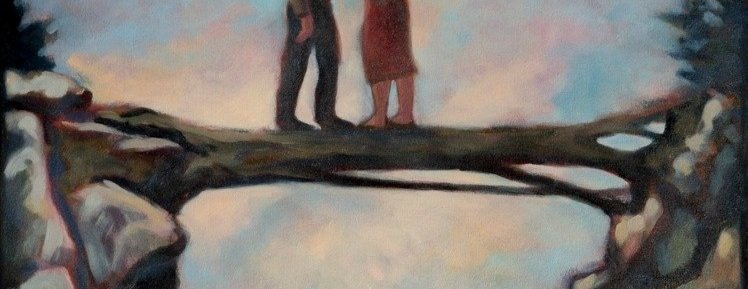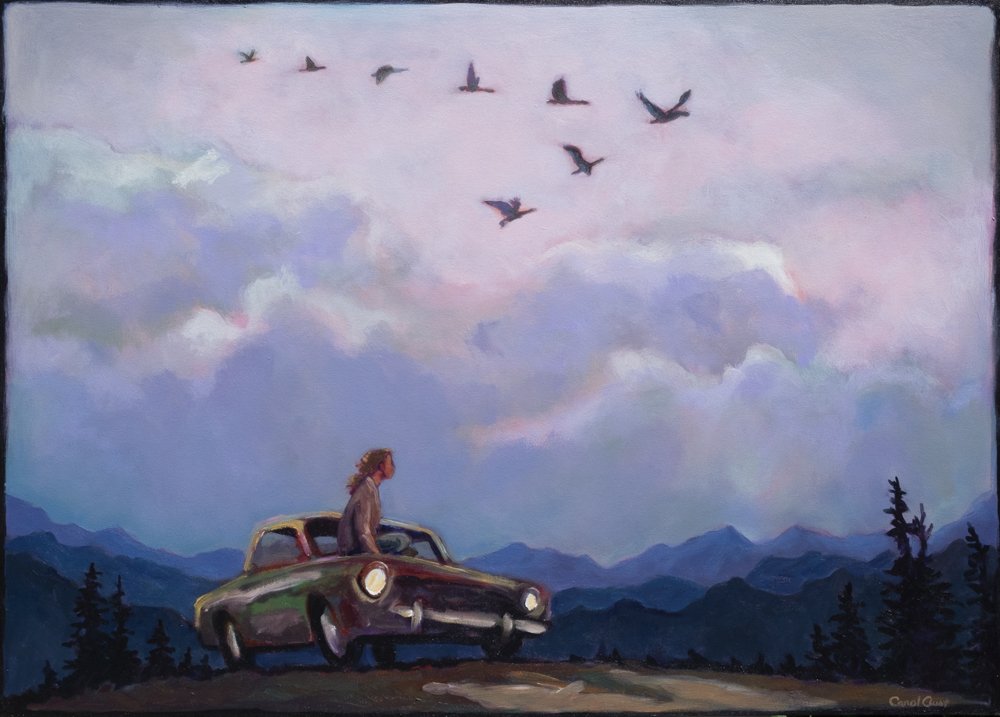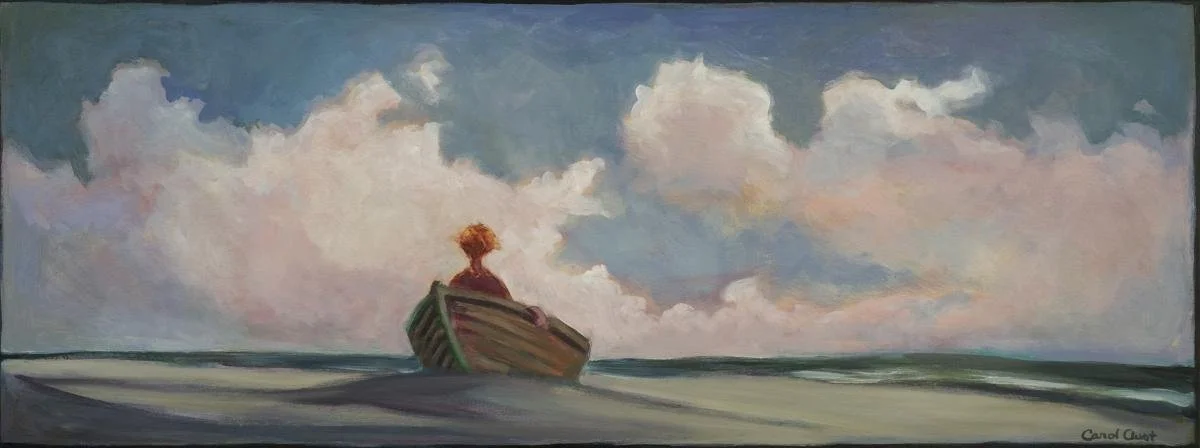
The BETWEEN Gallery
The Art of Transition
The evocative work of Carol Aust and the enduring wisdom of William Bridges express the upheaval, heartache, mystery, renewal and hope of transition.
Every transition begins with an end.
Transition is a constant and unsettling process that offers the chance of renewal, growth, and redemption.
All transitions are composed of an ending, a neutral BETWEEN zone, and a new beginning.
Even when the change in your life is good, transition is the difficult process of letting go of an old situation, suffering the confusing nowhere of inBETWEENness, and launching forth again in a new situation.
Many people are caught in a semipermanent condition of transitionally—stuck in transition BETWEEN situations, relationships, and identities that are also in transition.
Change is situational. Transition is psychological. Transition is not an event, but rather the inner reorientation and self-definition that you have to go through in order to incorporate various changes into your life. Without a transition, a change is just a rearrangement of the furniture.
One of the most important differences between a change and a transition is that changes are often driven to reach a goal, but transitions start with letting go of what no longer fits or is adequate to the life stage you are in. You need to figure out for yourself what exactly that no-longer-appropriate thing is. Here is a hint that can save you considerable pain and remorse:
Whatever it is that you need to let go of, it is internal.
Endings are experiences of dying. (Even when they are good.) They are ordeals, and sometimes they challenge so basically our sense of who we are that we believe they will be the end of us. An understanding of endings and some familiarity with old passage rituals can be helpful. As Mircea Eliade has written, “In no rite or myth do we find the initiatory death as something final, but always as a the condition sine qua non of a transition to another mode of being, a trial indispensable to regeneration; that is, to the beginning of a new life.
Although it might be true that you emerge from a time of transition with the clear sense that it is time for you to leave a job or end a relationship, that simply represents a change that your transition has prepared you to make. The transition itself begins with letting go of something you have believed or assumed, some way you’ve always been or seen yourself, some outlook on the world or attitude toward others.
Even though we are likely to view an ending as the conclusion of the situation it terminates, it is also the initiation of a process. Endings are the first, not the last, act of the play.
The BETWEEN Time
However you feel about the change in your life, the BETWEEN time of transition is marked with a sense of loss, confusion and emptiness. For many people in this neutral zone, their old reality looks transparent and nothing feels solid anymore.
While the order of transition is first an ending, then the neutral BETWEEN zone, then a new beginning; things do not stay lined up in their proper order in many people’s lives. The BETWEEN place of neutrality may actually precede a visible ending. Or it may come after a supposed beginning. Whether it overlaps with the old situation because inwardly some ending has already taken place, or whether it overlaps with the new situation because an inner new beginning has not yet been made, the neutral zone is a time of inner reorientation. Though the BETWEEN phase is the part of the process that most people want to ignore or rush, it is the time when the deep work of transition takes place.
In the BETWEEN time, we don’t know whether we are going crazy or becoming enlightened, and neither prospect is one that we feel we can readily discuss with anyone else. Finding a safe person to walk alongside you during this time can help. You don’t have to do the journey alone.
One of the first of the neutral-zone activities is surrender: you must give in to the emptiness and stop struggling to escape it.
Surrender is not easy, so it can be helpful to understand what makes the emptiness BETWEEN the old life and the new beginning so essential. Ultimately, this BETWEEN time provides the necessary space for the process of death and rebirth—which has the potential to bring renewal, perspective, and wisdom for life.
One of the difficulties of being in transition in the modern world is that we have lost our appreciation for this BETWEEN time and the supposed gap in our continuity of existence.
For many, “emptiness” represents only the absence of something. So when what’s missing is something as important as relatedness and purpose and reality, we try to find ways of replacing these missing elements as quickly as possible. The BETWEEN time, we imagine, cannot be a significant part of the transition process; we hope it can only be a temporary, if unfortunate, situation to be endured.
However, it is in the apparently aimless activity of the neutral zone that the important inner business of transformation takes place.
But you don’t do it as you do ordinary things, for it is in the walking, watching, making coffee, counting the birds on the phone wire, studying the cracks in the plaster ceiling over the bed, dreaming, and waiting for God knows what to happen that you are carrying on the basic industry of the BETWEEN neutral zone, which is attentive inactivity and ritualized routine.
[Wanting]
When you are in the BETWEEN of a transition, one of the most powerful questions to sit with is, “What do I want?”
It’s a deceptively slippery question.
Go beyond your first answer. Ask yourself again, “What do I want?”
“And what else?”
“So what do I really want?”
When you find an answer that rings deep and clear, you may see possibilities open up, a new beginning appear, a new adventure begin to unfold.
As much as we long for external signs that point the way to the future, we must settle for inner signals that alert us to the proximity of new beginnings. The most important of these signals begins as a faint intimation of something different, a new theme in the music, a strange fragrance on the breeze. Because the signal is very subtle, it is difficult to perceive when other stimuli are strong—and that is why we naturally, if unconsciously, seek emptiness and quietness in times of life transition.
Genuine beginnings depend on this kind of inner alignment rather than on external shifts, for it is when we are aligned with deep longings that we become powerfully motivated.
New Beginnings
And so, new beginnings emerge toward the end of our transition.
Genuine beginnings begin within us, even when they are brought to our attention by external opportunities. It is when the endings and the BETWEEN time of fallow neutrality are finished that we can launch ourselves anew, changed and renewed by the deconstruction of the structures of the old life phase and the subsequent journey through the neutral zone.
We forget how indirect and unimpressive most new beginnings really are, and we imagine instead some clear, conscious steps that we ought to be taking. The English novelist John Galsworthy was surely right when he wrote, “The beginnings of all human undertakings are untidy.”
New beginnings are accessible to everyone—and everyone has trouble with them. As much as we may wish to make a new beginning, some part of us resists doing so, as though we were making the first step toward disaster. Everyone has a slightly different version of these anxieties and confusions, but in one way or another they all arise from fear that real change destroys the old ways that we have learned to equate with who we are and what we need.
To make a successful new beginning, it is important to do more than simply persevere. It is important to understand what it is within us that undermines our resolve and casts doubt on our plans.
Throughout nature, growth involves periodic accelerations and transformations: things go slowly for a time and nothing seems to happen—until suddenly the eggshell cracks, the branch blossoms, the tadpole’s tail shrinks away, the leaf falls, the frog molts, or the hibernation begins.
With us it is the same. Although the signs are less clear than in the world of feather and leaf, the functions of transition times are the same. They are key times of development, renewal, and new beginnings.
We can support and enhance the process of new beginnings, but we cannot produce the results. Once those results begin to take shape, however, there are several things that can be done.
1) When the time comes, stop getting ready to do it (whatever it is)—and do it. 2) Begin to identify yourself with the final result of the new beginning. 3) Take things step by step, and resist the siren song that sings about some other route where everything goes smoothly and events are always exciting and meaningful. 4) Shift your purpose from the goal to the process of reaching the goal. 5) Be gentle with yourself and others in process. 6) And, celebrate the small steps and comforting continuities in your life when so much else is changing.
As much as we long for them, new beginnings can be things to be resisted just as much as the loss-filled ending and the ambiguous and frustrated neutral zone were. It’s also important to remember that not everything vanishes in the process of transition. You have been on a journey, but you haven’t become someone else. You are still you! Your transition is, after all, a new chapter beginning in your life.
The transition process involves a reintegration of your new identity with elements of your old one. This aspect of the beginning is as natural as the disintegration was back in the termination phase. Inwardly and outwardly, you come home.
Endings and beginnings—and emptiness and germination in BETWEEN: that is the shape of transition in our lives. These times come far more frequently—and cut far more deeply—than most of us ever imagined they would.
Your Life Transitions
The homeward journey of life’s second half demands three things: first, that we unlearn the style of mastering the world that we used to take us through the first half of life; second, that we resist our own longings to abandon the developmental journey and refuse the invitations to stay forever at some attractive stopping place; and third, that we recognize that it will take real effort to regain the inner “home.”
Which of your own life transitions has been the most significant so far?
Where are you now? In a season of ending, BETWEEN, or in a new beginning?
If you would like to talk with someone about your transition, please get in touch. I’d love to support you on your journey.
A personal reflection for times of transition:
Imagine that you are really old. Let’s say you’re ninety. From that time in the future, you can look back on yourself now. Then you’ll know what was really going on now and even how things turned out. You may also know how they might have turned out if you had taken a different path.
From that vantage point, was this present point in your life a time when it was a good idea to keep on in the same direction, or was it a time that cried out for change? And if the latter, what kind of change was called for? Looking back from age ninety, did you notice signs that pointed to the direction you ought to have taken at this point in your life, signs that may have been hard to see but that were there? And looking back from the future, what feelings do you have about your situation now? At ninety, are you sympathetic with your current confusion or impatient with your current obliviousness? At ninety, are you pleased by how things turned out or troubled by the nagging feeling that you missed a turn in the road back here where you’re standing now? Do you, at ninety, wish you could have encouraged your present self to take more risks? Or do you wish you could have made your present self wake up and see all that you already possessed and not risk it for something that was just ego candy?
To give these questions a little more vitality, take a few moments first to imagine the old you that you’ll be at ninety. Shut your eyes, and see whether you can picture your ninety-year-old hands. Imagine what your old body will feel like in whatever position you are now in. In your mind, populate the world that the old you will be living in: Who will be there, and who won’t? Where will you be living? How will you spend your days? When you have let your imagination stretch out that world, try going back to any of the earlier questions that didn’t seem answerable at the time, and let the ninety-year-old person who lives in that world answer the question.
And remember: you know more than you think you know!
More about transitions can be found on the BETWEEN Resource page.
MANY THANKS to Carol Aust for her amazing generosity, beauty and creativity. I have always loved how Carol’s paintings portray both fear and/or hope, crisis and/or opportunity, joy and/or anguish, especially in the eye and heart of the beholder. Carol’s work has been especially poignant as I continue to learn about the integral “both/and” of life transitions. A link to Carol’s website and all of her paintings is below. Enjoy! The written content of the BETWEEN gallery is compiled from William Bridges’ 40th Anniversary Edition copy of Transitions: Making Sense of Life’s Changes. I highly recommend this book and his other work as well. I am so, so grateful for the incredible gifts and wisdom of both Carol Aust and William Bridges. You have both taught me so much about life!





























































